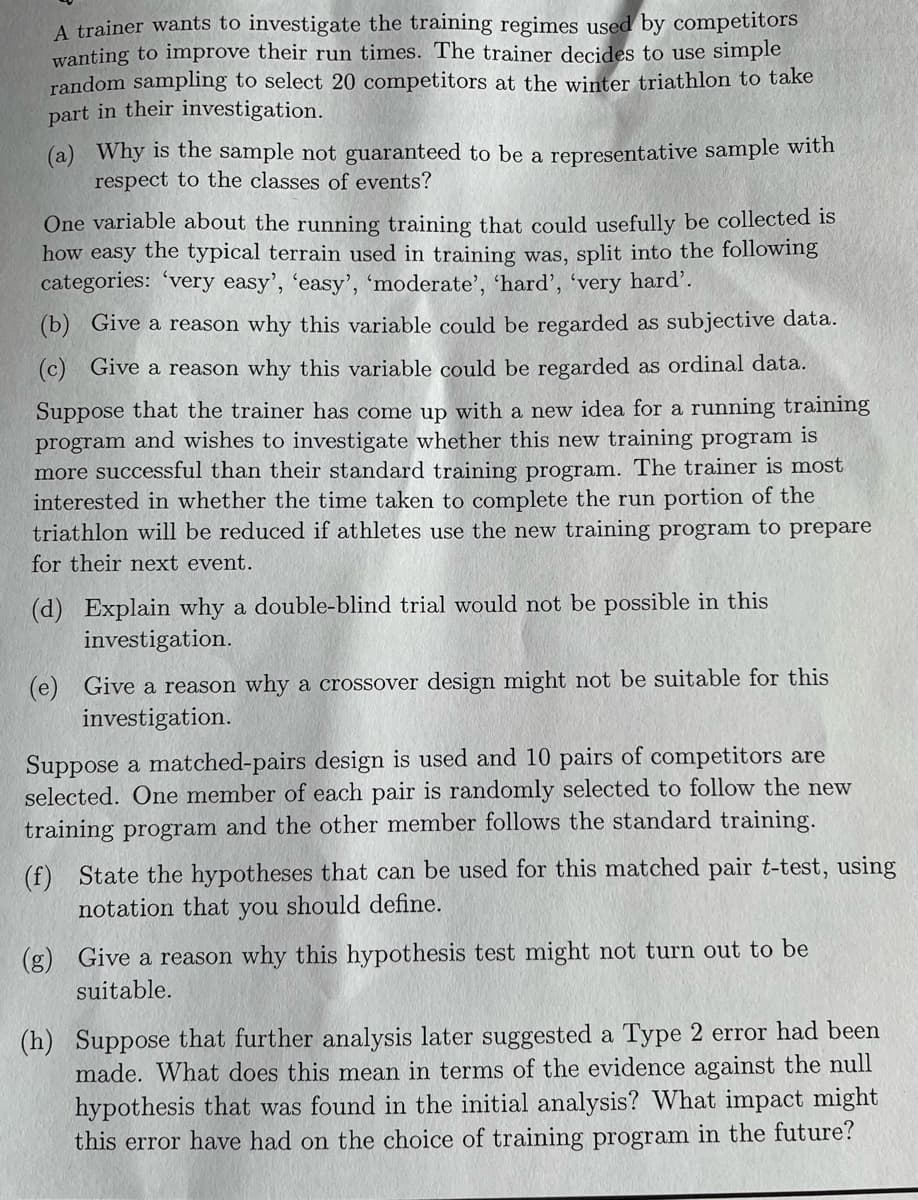(a) Why is the sample not guaranteed to be a representative sample with respect to the classes of events? One variable about the running training that could usefully be collected is how easy the typical terrain used in training was, split into the following categories: 'very easy', 'easy', 'moderate', 'hard', 'very hard'. (b) Give a reason why this variable could be regarded as subjective data. (c) Give a reason why this variable could be regarded as ordinal data.
(a) Why is the sample not guaranteed to be a representative sample with respect to the classes of events? One variable about the running training that could usefully be collected is how easy the typical terrain used in training was, split into the following categories: 'very easy', 'easy', 'moderate', 'hard', 'very hard'. (b) Give a reason why this variable could be regarded as subjective data. (c) Give a reason why this variable could be regarded as ordinal data.
Glencoe Algebra 1, Student Edition, 9780079039897, 0079039898, 2018
18th Edition
ISBN:9780079039897
Author:Carter
Publisher:Carter
Chapter10: Statistics
Section10.3: Measures Of Spread
Problem 1GP
Related questions
Question
A,B and C
Will follow up further parts

Transcribed Image Text:A trainer wants to investigate the training regimes used by competitors
wanting to improve their run times. The trainer decides to use simple
random sampling to select 20 competitors at the winter triathlon to take
part in their investigation.
(a) Why is the sample not guaranteed to be a representative sample with
respect to the classes of events?
One variable about the running training that could usefully be collected is
how easy the typical terrain used in training was, split into the following
categories: 'very easy', 'easy', 'moderate', 'hard', 'very hard'.
(b) Give a reason why this variable could be regarded as subjective data.
(c) Give a reason why this variable could be regarded as ordinal data.
Suppose that the trainer has come up with a new idea for a running training
program and wishes to investigate whether this new training program is
more successful than their standard training program. The trainer is most
interested in whether the time taken to complete the run portion of the
triathlon will be reduced if athletes use the new training program to prepare
for their next event.
(d) Explain why a double-blind trial would not be possible in this
investigation.
(e) Give a reason why a crossover design might not be suitable for this
investigation.
Suppose a matched-pairs design is used and 10 pairs of competitors are
selected. One member of each pair is randomly selected to follow the new
training program and the other member follows the standard training.
(f) State the hypothes that can be used for this matched pair t-test, using
notation that you should define.
(g) Give a reason why this hypothesis test might not turn out to be
suitable.
(h) Suppose that further analysis later suggested a Type 2 error had been
made. What does this mean in terms of the evidence against the null
hypothesis that was found in the initial analysis? What impact might
this error have had on the choice of training program in the future?
Expert Solution
This question has been solved!
Explore an expertly crafted, step-by-step solution for a thorough understanding of key concepts.
Step by step
Solved in 2 steps

Recommended textbooks for you

Glencoe Algebra 1, Student Edition, 9780079039897…
Algebra
ISBN:
9780079039897
Author:
Carter
Publisher:
McGraw Hill

Holt Mcdougal Larson Pre-algebra: Student Edition…
Algebra
ISBN:
9780547587776
Author:
HOLT MCDOUGAL
Publisher:
HOLT MCDOUGAL

College Algebra (MindTap Course List)
Algebra
ISBN:
9781305652231
Author:
R. David Gustafson, Jeff Hughes
Publisher:
Cengage Learning

Glencoe Algebra 1, Student Edition, 9780079039897…
Algebra
ISBN:
9780079039897
Author:
Carter
Publisher:
McGraw Hill

Holt Mcdougal Larson Pre-algebra: Student Edition…
Algebra
ISBN:
9780547587776
Author:
HOLT MCDOUGAL
Publisher:
HOLT MCDOUGAL

College Algebra (MindTap Course List)
Algebra
ISBN:
9781305652231
Author:
R. David Gustafson, Jeff Hughes
Publisher:
Cengage Learning
